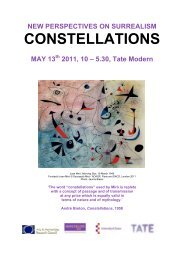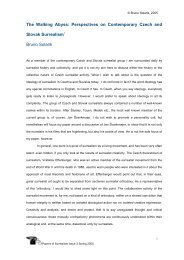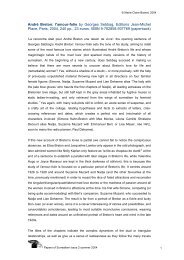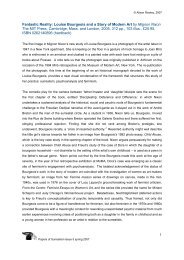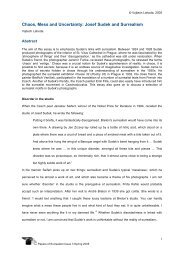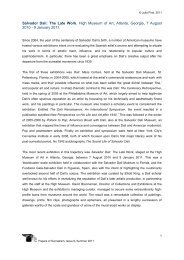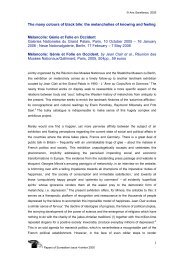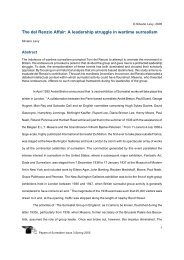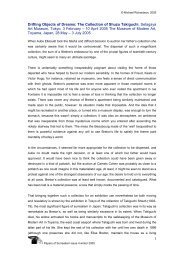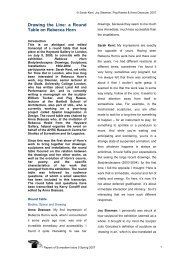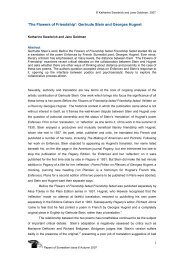From the Walls of Factories to the Poetry of the Street: Inscriptions ...
From the Walls of Factories to the Poetry of the Street: Inscriptions ...
From the Walls of Factories to the Poetry of the Street: Inscriptions ...
You also want an ePaper? Increase the reach of your titles
YUMPU automatically turns print PDFs into web optimized ePapers that Google loves.
© Caroline Levitt, 2011<br />
12 Apollinaire initially used <strong>the</strong> term <strong>to</strong> refer <strong>to</strong> <strong>the</strong> work <strong>of</strong> Chagall, who saw little correlation between<br />
Apollinaire‟s term and <strong>the</strong> au<strong>to</strong>matism <strong>of</strong> <strong>the</strong> surrealists, see Georges Charbonnier, Le monologue du<br />
peintre (Paris, 1959), Durier, Neuilly-sur-Seine, 1980, 241. More generally, however, it s<strong>to</strong>od for a<br />
heightened sense <strong>of</strong> <strong>the</strong> intensity <strong>of</strong> phenomenal reality that serves <strong>to</strong> make <strong>the</strong> real seem strange<br />
and mystical: a new reality, in o<strong>the</strong>r words, created from <strong>the</strong> natural elements <strong>of</strong> perception, yet<br />
combined with <strong>the</strong> fantastic images <strong>of</strong> <strong>the</strong> mind. This understanding <strong>of</strong> <strong>the</strong> word fits neatly with Bre<strong>to</strong>n<br />
and Soupault‟s agenda and is taken from a paragraph concerning surnaturalisme in Les Soirées de<br />
Paris, No. 24, May-June 1914, n. p.<br />
13 Guillaume Apollinaire, „L‟Enchanteur pourrissant‟ (1909), in Œuvres en prose complètes, Vol. 1, 76<br />
(„Cent matelots m‟acceuillirent et m‟ayant mené dans un palais, ils m‟y tuèrent quatre-vingt-dix-neuf<br />
fois. J‟éclatai de rire à ce moment et dansai tandis qu‟ils pleuraient. Je dansai à quatre pattes‟).<br />
14 André Bre<strong>to</strong>n, Manifeste du surréalisme (1924), in Œuvres complètes, 4 vols, Marguérite Bonnet,<br />
Philippe Bernier P, Etienne-Alain Hubert, José Pierre, eds, Pléiade, Paris, 1988, 1992, 1999, 2008,<br />
Vol. 1, 311.<br />
15 André Bre<strong>to</strong>n, Manifeste du surréalisme, 346 („La terre drapée dans sa verdure me fait aussi peu<br />
d‟effet qu‟un revenant. C‟est vivre et cesser de vivre qui sont des solutions imaginaires. L‟existence<br />
est ailleurs‟).<br />
16 André Bre<strong>to</strong>n, Nadja (1928), in Œuvres complètes, Vol. 1, 736 („je ne pense pas qu‟il puisse y avoir<br />
une extrême différence entre l‟intérieur d‟un asile et l‟extérieur‟).<br />
17 Ibid., 736 (Il doit, hélas! y avoir <strong>to</strong>ut de même une différence, à cause du bruit agaçant d‟une clé<br />
qu‟on <strong>to</strong>urne dans une serrure, de la misérable vue de jardin, de l‟aplomb des gens qui vous<br />
interrogent quand vous n‟en voudriez pas‟).<br />
18 Guillaume Apollinaire, ed., Les Maîtres de l’amour: l’œuvre du Marquis de Sade, Bibliothèque des<br />
curieux, Paris, 1909, 12, 17. („il aimait par-dessus <strong>to</strong>ut la liberté;‟ „cet esprit le plus libre qui ait encore<br />
existé‟). Until 1913 <strong>the</strong>re was no catalogue <strong>of</strong> <strong>the</strong> censored books in <strong>the</strong> „enfer,‟ making <strong>the</strong>m<br />
unconsultable. The first catalogue, entitled <strong>the</strong> „Icono-bio-biographie‟ was created by Apollinaire<br />
himself, with Louis Perceau and Fernand Fleuret in 1913 and included all <strong>the</strong> books deposited <strong>the</strong>re<br />
<strong>to</strong> date, notably those by <strong>the</strong> Marquis de Sade.<br />
19 Guillaume Apollinaire, Les Maîtres de l’amour: l’œuvre du Marquis de Sade, 20 („J‟ai suivi la route<br />
du vice, moi, mon enfant; je n‟y ai jamais rencontré que des roses‟).<br />
20 „Le Roi-Lune‟ was published as part <strong>of</strong> <strong>the</strong> anthology Le Poète assassiné, which also included<br />
Apollinaire‟s roman à clé <strong>of</strong> that title. Guillaume Apollinaire, „Le Roi-Lune‟ (1916), in Œuvres en prose<br />
complètes, Vol. 1, 307.<br />
21 The text more than cursorily recalls Roussel‟s Impressions d’Afrique (1910), which Apollinaire had<br />
seen with Duchamp and Picabia in 1912.<br />
22 Apollinaire, „Le Roi-Lune,‟ 308.<br />
23 Ibid., 312.<br />
24 The <strong>to</strong>othpaste tin was later owned by Richard Anacréon, a bookseller and art collec<strong>to</strong>r. See,<br />
Elisabeth Noël Le Con<strong>to</strong>ur, Le Merle blanc de la Monaco du nord: Richard Anacréon 1907-1992,<br />
Harmattan, Paris, 2001. A pho<strong>to</strong>graph <strong>of</strong> <strong>the</strong> object is held at <strong>the</strong> Bibliothèque litéraire Jacques<br />
Doucet, Paris.<br />
25 For <strong>the</strong> dating <strong>of</strong> this poem, and its inclusion in letters <strong>to</strong> Louise Faure-Favier, Madeleine Pagès<br />
and Louise de Coligny-Chatillon, see <strong>the</strong> notes in Œuvres poétiques, 1096. It was later included in<br />
Calligrammes (1918).<br />
Papers <strong>of</strong> Surrealism, Issue 9, Summer 2011 21




